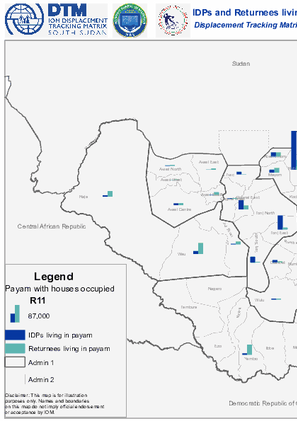-
Countries
-
Data and Analysis
-
Special Focus
-
Crisis Responses
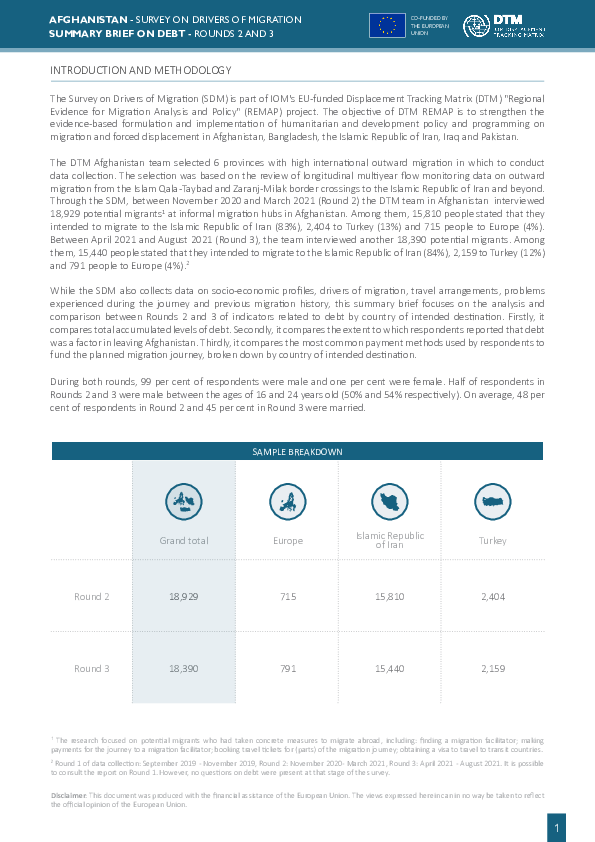
Contact
DTMAfghanistan@iom.int
Language
English
Location
Afghanistan
Period Covered
Nov 01 2020
Aug 31 2021
Activity
- Survey
- Flow Monitoring
The Survey on Drivers of Migration (SDM) is part of IOM's EU-funded Displacement Tracking Matrix (DTM) "Regional
Evidence for Migration Analysis and Policy" (REMAP) project. The objective of DTM REMAP is to strengthen the
evidence-based formulation and implementation of humanitarian and development policy and programming on
migration and forced displacement in Afghanistan, Bangladesh, the Islamic Republic of Iran, Iraq and Pakistan.
The DTM Afghanistan team selected 6 provinces with high international outward migration in which to conduct
data collection. The selection was based on the review of longitudinal multiyear flow monitoring data on outward
migration from the Islam Qala -Taybad and Zaranj -Milak border crossings to the Islamic Republic of Iran and beyond.
Through the SDM, between November 2020 and March 2021 (Round 2) the DTM team in Afghanistan interviewed
18,929 potential migrants at informal migration hubs in Afghanistan. Among them, 15,810 people stated that they
intended to migrate to the Islamic Republic of Iran (83%), 2,404 to Turkey (13%) and 715 people to Europe (4%).
Between April 2021 and August 2021 (Round 3), the team interviewed another 18,390 potential migrants. Among
them, 15,440 people stated that they intended to migrate to the Islamic Republic of Iran (84%), 2,159 to Turkey (12%)
and 791 people to Europe (4%).

Contact
vlutenco@iom.int
Language
Mongolian
Location
Mongolia
Period Covered
Feb 01 2022
Feb 28 2022
Activity
- Mobility Tracking
- Baseline Assessment
ОУШХБ-ын өмнөх судалгаануудаар газрын доройтол, уур амьсгалын өөрчлөлт зэрэг асуудлууд нь Монголын уламжлалт амьдралын хэв маягийг өөрчилж байгааг тогтоожээ. Ган зудын давтамж нэмэгдэж, ажлын байр хомс, амьдрах орчин нөхцөл шаардлага хангахгүй, хөдөөгийн хүн ам малаас хэт хараат болсон зэрэг нь хөдөөгийн хүн амын амьжиргааг залгуулах боломжийг өдрөөс өдөрт бууруулсаар байна. Үүний зэрэгцээ энэ байдал нь хот суурин газар болон бусад аймгийн төв рүү чиглэсэн шилжилт хөдөлгөөнийг нэмэгдүүлэх хүчин зүйл болсоор байна. Эдгээр шинээр гарч ирж буй шилжилт хөдөлгөөний (хүн амын хөдөлгөөн) хэв маяг нь тооллогын, бүртгэлийн мэдээлэл болон Монгол Улсын хэмжээнд амьдарч буй хүмүүсийн бодит тоон мэдээлэл хооронд ихээхэн зөрүү үүсгэсээр байна. Энэхүү туршилтын судалгаагаар ҮСХ болон ОУШХБ нь хамтран Өмнөговь, болон Дундговь аймгуудад багийн байршил дээрх хүн амын бодит тоог тандах зорилгоор Хүн амын хөдөлгөөнийг тандах матрицын “Хөдөлгөөний тандалт” – MT (Mobility Tracking) аргачлалыг ашиглахыг зорьсон юм.

Contact
vlutenco@iom.int
Language
English
Location
Mongolia
Period Covered
Feb 01 2022
Feb 28 2022
Activity
- Mobility Tracking
- Baseline Assessment
Previous IOM studies have found that a combination of complex effects, including land degradation and climate change, are altering traditional livelihood patterns in Mongolia. In a context of increased frequency of droughts and dzuds, the lack of job opportunities, inadequate living conditions, and the dependency of the rural population on livestocks have reduced the rural population's ability to earn a living. At the same time, this situation increased migration to urban areas and other aimags in unprecedented and unexplored ways. These emerging migration patterns created a large discrepancy between census data, registration data, and actual number of people living in the various baghs in Mongolia. With this study, DTM and National Statistics Office (NSO) intend to use the Mobility Tracking (MT) methodology of the DTM toolbox to track a more accurate number of people living in the various baghs in Umnugovi aimags.
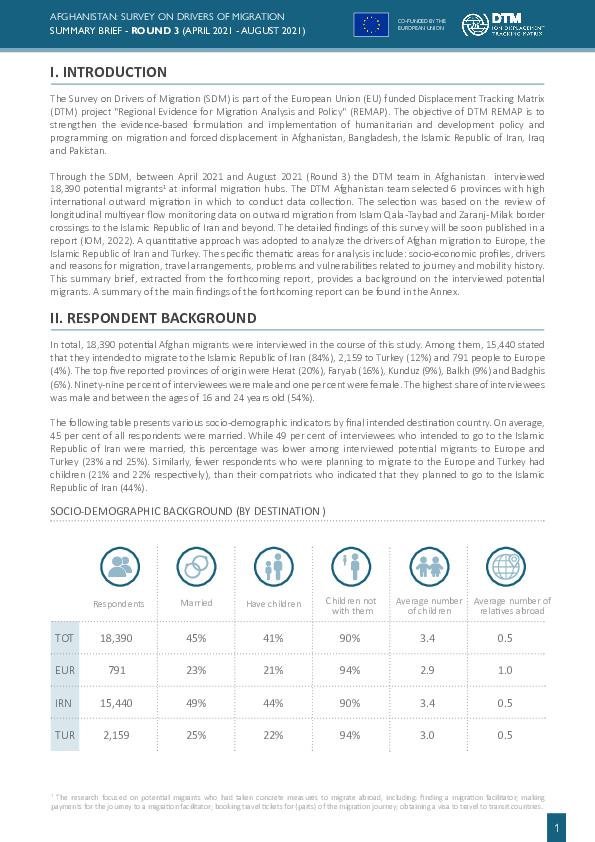
Contact
DTM Afghanistan, DTMAfghanistan@iom.int
Language
English
Location
Afghanistan
Period Covered
Apr 01 2021
Aug 31 2021
Activity
- Survey
- Flow Monitoring
The Survey on Drivers of Migration (SDM) is part of the European Union (EU) funded Displacement Tracking Matrix (DTM) project "Regional Evidence for Migration Analysis and Policy" (REMAP). The objective of DTM REMAP is to strengthen the evidence-based formulation and implementation of humanitarian and development policy and programming on migration and forced displacement in Afghanistan, Bangladesh, the Islamic Republic of Iran, Iraq and Pakistan.
Through the SDM, between April 2021 and August 2021 (Round 3) the DTM team in Afghanistan interviewed 18,390 potential migrants1 at informal migration hubs. The DTM Afghanistan team selected 6 provinces with high international outward migration in which to conduct data collection. The selection was based on the review of longitudinal multiyear flow monitoring data on outward migration from Islam Qala -Taybad and Zaranj -Milak border crossings to the Islamic Republic of Iran and beyond. The detailed findings of this survey will be soon published in a report (IOM, 2022). A quantitative approach was adopted to analyze the drivers of Afghan migration to Europe, the Islamic Republic of Iran and Turkey. The specific thematic areas for analysis include: socio-economic profiles, drivers and reasons for migration, travel arrangements, problems and vulnerabilities related to journey and mobility history.
This summary brief, extracted from the forthcoming report, provides a background on the interviewed potential migrants.
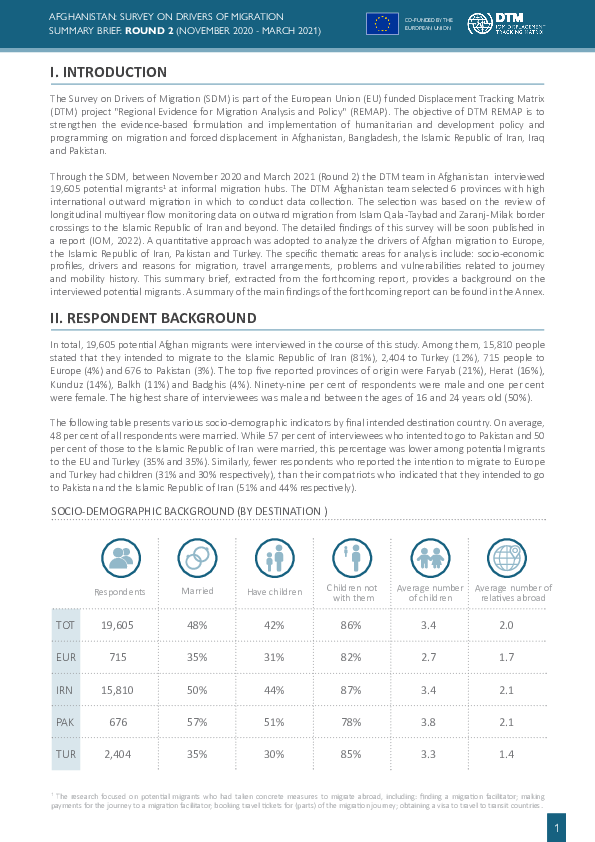
Contact
DTM Afghanistan, DTMAfghanistan@iom.int
Language
English
Location
Afghanistan
Period Covered
Nov 01 2020
Mar 21 2021
Activity
- Survey
- Flow Monitoring
The Survey on Drivers of Migration (SDM) is part of the European Union (EU) funded Displacement Tracking Matrix
(DTM) project "Regional Evidence for Migration Analysis and Policy" (REMAP). The objective of DTM REMAP is to
strengthen the evidence-based formulation and implementation of humanitarian and development policy and
programming on migration and forced displacement in Afghanistan, Bangladesh, the Islamic Republic of Iran, Iraq
and Pakistan.
Through the SDM, between November 2020 and March 2021 (Round 2) the DTM team in Afghanistan interviewed
19,605 potential migrants at informal migration hubs. The DTM Afghanistan team selected 6 provinces with high
international outward migration in which to conduct data collection. The selection was based on the review of
longitudinal multiyear flow monitoring data on outward migration from Islam Qala -Taybad and Zaranj -Milak border
crossings to the Islamic Republic of Iran and beyond. The detailed findings of this survey will be soon published in
a report (IOM, 2022). A quantitative approach was adopted to analyze the drivers of Afghan migration to Europe,
the Islamic Republic of Iran, Pakistan and Turkey. The specific thematic areas for analysis include: socio-economic
profiles, drivers and reasons for migration, travel arrangements, problems and vulnerabilities related to journey
and mobility history. This summary brief, extracted from the forthcoming report, provides a background on the
interviewed potential migrants.
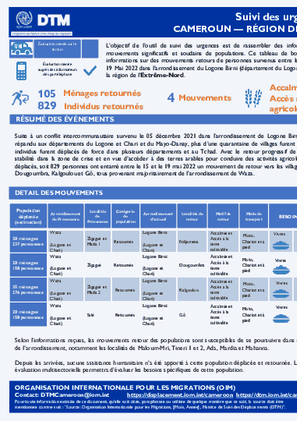
Contact
DTM Cameroon, DTMCameroun@iom.int
Language
French
Location
Cameroon
Period Covered
May 16 2022
May 19 2022
Activity
- Mobility Tracking
- Event Tracking
L’objectif de l’outil de suivi des urgences est de rassembler des informations sur les mouvements significatifs et soudains de populations. Ce tableau de bord présente des informations sur des mouvements retours de personnes survenus entre le 16 Mai 2022 et 19 Mai 2022 dans l’arrondissement du Logone Birni (département du Logone et Chari) dans la région de l’Extrême-Nord.
Suite à un conflit intercommunautaire survenu le 05 décembre 2021 dans l’arrondissement de Logone Birni et rapidement répandu aux départements du Logone et Chari et du Mayo-Danay, plus d’une quarantaine de villages furent détruits et xxxx individus furent déplacés de force dans plusieurs départements et au Tchad. Avec le retour progressif de la paix et de la stabilité dans la zone de crise et en vue d’accéder à des terres arables pour conduire des activités agricoles, 105 ménages déplacés, soit 829 personnes ont entamé entre le 15 et le 19 mai 2022 un mouvement de retour vers les villages de Ndjamena, Dougoumbra, Kalgoulou et Gô, tous provenant majoritairement de l’arrondissement de Waza.

Contact
DTM Support — iomdrcdtm@iom.int
Language
French
Location
Democratic Republic of the Congo
Period Covered
May 12 2022
May 17 2022
Activity
- Mobility Tracking
- Event Tracking
L’évaluation rapide de l’OIM (Emergency Tracking Tool, ETT) est un outil mis en place dans le but de collecter des informations sur les mouvements importants et soudains de populations. Ces informations sont collectées à la suite de visites sur le terrain et/ou d’entretiens téléphoniques avec les informateurs clés des sites de déplacement ou des communautés d’accueil. D’autres informations sont ensuite recueillies et analysées à partir des outils d’Evaluation Rapide Multisectorielle (ERM). Ce rapport présente les résultats de l'évaluation menée à la fois sur le terrain et à travers des entretiens téléphoniques avec des informateurs clés du 12 au 17 mai 2022.
Depuis le 10 mai, des affrontements entre des milices Twa et des groupes de jeunes Bantous se réclamant d'une force d'autodéfense ont été signalés dans trois villages identifiés comme sites d'exploitation artisanale de l'or dans le groupement Rutuku, chefferie de Tumbwe, territoire de Kalemie, province du Tanganyika. Ces trois villages, Mala, Katolo et Musipi, ont été complètement incendiés au moment de ces exactions. Suite à cet événement, plus récemment le 14 - 15 mai, les villages de Mulembwe, Mpemba, Kawama et Katombo, ont été vidés d'environ 90 % de leur population. Par ailleurs, dans le cadre de mouvements préventifs contre une nouvelle attaque annoncée par la milice Twa sur l'axe Moba - Kalemie, les sites de Likasi, Kisalaba et Mwaka sous la coordination de l'OIM se vident progressivement. La population, estimée à 25 197 individus en quête de protection et de sécurité, a fui sur deux axes : la majorité au nord, vers la ville de Kalemie et au sud dans les villages de Kyempele, Kanoya, Tumbwe et dans les villages de Kawama et Pungwe, tous situés dans la chefferie de Tumbwe.

Contact
DTM Support — iomdrcdtm@iom.int
Language
French
Location
Democratic Republic of the Congo
Period Covered
May 09 2022
May 15 2022
Activity
- Mobility Tracking
- Event Tracking
L’évaluation rapide de l’OIM (Emergency Tracking Tool, ETT) est un outil mis en place dans le but de collecter des informations sur les mouvements importants et soudains de populations. Ces informations sont collectées à la suite de visites sur le terrain et/ou d’entretiens téléphoniques avec les informateurs clés des sites de déplacement ou des communautés d’accueil. D’autres informations sont ensuite recueillies et analysées à partir des outils d’évaluation rapide multisectorielle (ERM). Ce rapport présente les résultats de l’évaluation menée sur le terrain le 09 mai 2022 dans le site de Djaiba dans le territoire de Djugu.
Dans la nuit du 9 mai 2022, une incursion attribuée à des éléments de la milice CODECO a été signalée dans le site de déplacement de Lodha, dans le territoire de Djugu, dans la province de l'Ituri. Cette milice serait originaire de la localité d'AR', dans le groupement de Fataki. Cette incursion a provoqué un déplacement massif de la population vivant dans le site de déplacement de Lodha, vers le site voisin de Djaiba, situé à quelques kilomètres du camp de la MONUSCO dans le village de Laybo, dans le groupement de Djaiba, dans le territoire de Djugu. Suite aux interventions de l'armée congolaise FARDC et des casques bleus népalais de la MONUSCO, il a été constaté, le 12 mai 2022, que la majorité des personnes déplacées accueillies dans le site de Djaiba ont regagné leur site d'origine (Lodha), et que seuls 130 Ménages d'environ 700 Individus sont encore présents dans le site de Djaiba répartis dans différents Blocs.

Contact
DTM Nigeria, AllUsersInDTMNigeria@iom.int
Language
English
Location
Nigeria
Period Covered
Mar 21 2022
Mar 21 2022
Activity
- Registration
- Biometric Registration
Following the completion of Biometric Registration at Muna El Badawy Camp in Jere Local Government Area (LGA) in the state of Borno, 5,799 households and 28,251 individuals were registered as per 21 March 2022, the average family size in the camp is five individuals. Fifteen per cent of the families consist of 1-2 members, 33 per cent comprising 3-4 members, 31 per cent comprising 5-6 members, 15 per cent comprising 7-8 members, 5 per cent comprising 9-10 and 2 percent comprising of 11 and more members.
Additionally, return intention data was collected to ascertain if residents of the camp are willing to return to their locations of origin, remain in the camp or relocate to a different location. More than 99 per cent of respondents are willing to leave the camp while less than one per cent are willing remain in the camp. Fifty-one per cent of IDPs in the camp are willing to return to their place of origin, 47 per cent are willing to return to place of habitual residence and two per cent are willing to relocate to a different locality (nearby town or state).
Vulnerability data was collected to identify individuals who may require additional humanitarian assistance. Fourteen per cent of the registered individuals were categorized as afflicted by one or more vulnerabilities. Some of the vulnerabilities included breastfeeding mothers (56 per cent), pregnant women (14 per cent), special protection needs (13 per cent), single parent headed households (nine per cent), physically disadvantaged (four per cent), visual impairment (two per cent), serious medical conditions (one per cent), mentally disabled (one per cent), others less than (one per cent.) etc.
